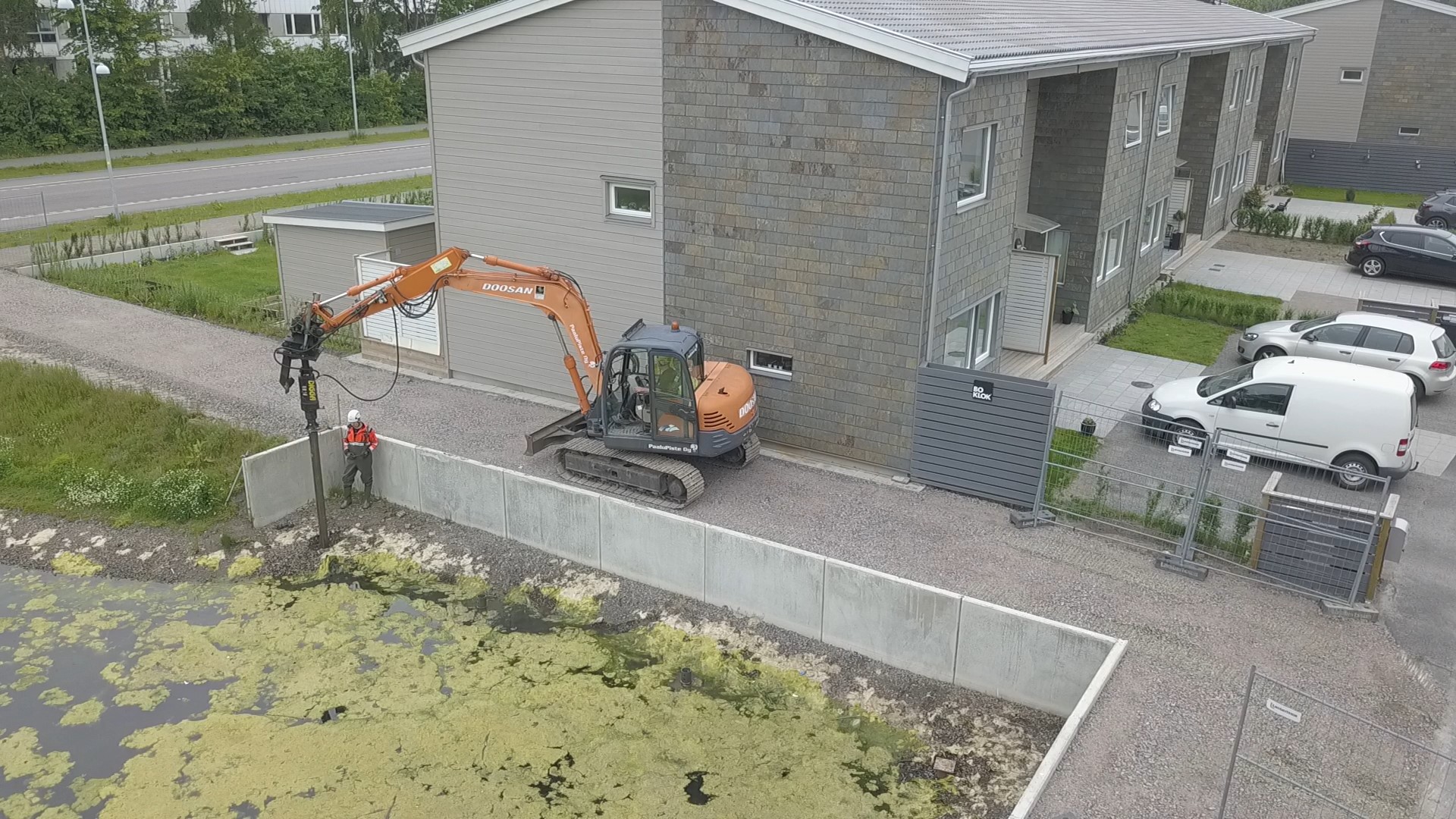What is a Helical Pile ?
Helical pile is a round shaft open steel pipe pile with one or more helical plates welded to the pipe near the tip. The pile is installed by rotating the pipe shaft. As the shaft rotates, the spiral plate advances into the ground, "pulling" the pipe shaft with it.
The helices give the foundation a bearing capacity, enabling them to be used for many applications across many industries and sectors.
A helical bearing plate or helix is one pitch of a screw thread. The helices do not auger into the soil but screw with minimal soil disturbance. Installation depth is limited only by soil density and practicality based on economics.
Helical Pile Benefits
Helical piles are designed to suit the ground conditions and the application requirements and come in various lengths and thicknesses. Helical piles have a high load- and tension capacity. Still, at the same time, helical piles are relatively inexpensive because they save the use of the material and are very fast to install.
The helical pile is a versatile, environmentally friendly, and cost-effective technology with many uses across civil engineering industries such as buildings, transport, solar, electricity, and telecommunications.
Helical pile installation is fast; the installation equipment is small, and the process is cost-efficient and does not require excavation, soil removal, frost protection, or dewatering. Installation does not cause noise or vibration making it possible to work in a quiet environment. The lack of vibration allows the helical piles to work near existing structures and industrial areas with vibration-sensitive equipment.
What are the main applications where Rotopile Helical Piles can be used?
Rotopile Helical piles have a number of applications where they can be used. The most common ones are housing projects, industrial halls, gas- and oil pipelines, structures on highways and railways, electric transmission lines, solar farms, footbridges and boardwalks, underwater applications, agricultural applications etc.
Because of the large variety of the sizes of Rotopile helical piles the applications can vary from light terrace foundations to a high capacity wind turbine foundations.
How do Helical Piles work to resist loads and what is the load capacity of Rotopile Helical Piles?
Helical Piles provide resistance to load through the friction of the pipe shaft. The amount of load taken by the shaft and the helical plate depends on the soils, the length and diameter of the shaft, and the helical plates.
The load capacity available from the soil depends on the soil strength, geometry of the helical pile, size, type, and length of the shaft and helical plates.
Usually, the strength of the soil controls load capacity. Typical SWL Load Capacity: The Rotopile Helical Pile provides for SWL capacities from as little as 10kN up to 1,000kN per pile, i.e., from 1 Ton up to 100 Ton capacity per pile. The world record loads using helical piles have been over 5,000 kN per single pile.
What are the typical Pile Lengths?
So, the length of the Helical Pile is determined from the depth to the target layer in the ground or onto the rock. In practice, helical pile lengths in the ground can be as little as 1 meter and as long as 40 meters in the ground, even longer, but most common depths range between 3 and 9 meters.
How long does it take to install a Helical Pile?
Helical piles are installed using conventional construction equipment like excavators or truck cranes equipped with low-speed, high-torque, and hydraulic torque motors. The motor is attached directly to the hydraulics of the machine. Handheld machines are used in smaller DIY piles and sites with restricted access to bigger machines. A typical rotation installation speed is about 8 to 25 revolutions per minute.
The pile can be installed to almost any depth by adding additional shaft sections but cannot be used to penetrate large gravel or bedrock. With a typical helical pitch of 75mm, it takes about 1min to advance each 1,20m depth, so about 5 minutes for a 6m installation. A few minutes are also needed to set up each location and add extensions.
Depending on location and the solution designed, helical piles can be installed at angles up to 45°on any soil condition, excluding rock. The helical pile can be installed at approx. 25-50cm from the wall of the existing structure. The minimum distance of two helical piles is three times the diameter of the largest helice.
How much will it cost to install Rotopile Helical Piles for my project?
Cost depends on each project, but the cost of Helical Piles is extremely competitive since no special equipment needs to be mobilized, like a crane or pile hammer. The installation cost is more competitive than other foundations. The project moves fast when installation scheduling is easy, and site disruption is minimal. A cost analysis for foundation comparisons is made in units of € per ton of load capacity, including project management and site preparation costs.
How do I know which Helical Pile to use for my project?
Rotopile has a wide selection of standard-size Helical Piles available. Still, the final selection should be made by a Geotechnical Engineer who is familiar with this technology and will consider your project's expected design loads. Rotopile offers all the services from soil examination to pile design to manufacturing and installation.
Do I need to worry about the corrosion ?
No, you don’t. The piles are carefully designed to fulfill the service life requirements of every single project. Usually, this is done by designing sufficient sacrificial wall thickness for the piles, but in very aggressive soils. Epoxy paint is commonly used to protect the welding seams from corrosion. Also, you can add sacrificial zinc.
How old is the Helical Pile technology?
The technology has been around since the mid-1800s and has been used extensively for about 60 years. However, there has been a rise in its use throughout the world, especially in the USA, Canada, and Australia. Finland and Sweden have been at the forefront of Helical Piles in Europe.
How Much site disturbance I can expect and w here can I find more information about the sustainability of the Rotopile Helical Piles?
The installation of helical piles produces little disturbance to the site. Low noise and zero vibration levels decrease disturbance, reduce soil disposal and keep the site clean.
Screw pile equipments have a small footprint and produce minimal disruption to adjacent structures. Helical piles are especially useful for supporting temporary structures since they can be removed and reused. Please contact our customer service for more information about Rotopile sustainability. We also have CO2-footprint calculations available on request.
How is Rotopile Helical Piles a good choice for my project?
Rotopile helical piles offer several benefits to projects. The installation is fast and this saves time and–expenses. Rotopile helical piles are also a clean choice, they protect the site and have a low CO2 footprint.
I’m an architect ( or a construction engineer ), and I would like to know more about Helical Piles and how to use them in projects. Do you offer training for Helical Pile design?
Yes. Contact us if you have any questions or need help designing the pile size; we are here to help. We can organize online training for you and your team with our experienced design engineers. We can also supply you a design material in English. Please don't hesitate to contact us . The sooner we are involved in the project, the better it is.
I have a project overseas; can I still use Rotopile Helical Piles as a foundation?
Yes. We ship our products overseas, and our installation team works internationally. We can also provide comprehensive installation training with the equipment (earth drill) if it ́s more convenient to install the piles with the local excavator operator.
I own an earthmoving/excavation company, and I'm interested in providing and installing the Rotopile Helical Piles. Can I get the required equipment from you and the training to perform the Helical Pile installations?
Yes. We will provide the earth drill for the helical pile installation that fits perfectly with your existing machinery (excavators, front loaders, telehandlers, or truck cranes). We can also provide you with installation training.
Our company is investing in a solar farm project. Helical Piles could be a good solution for a foundation. Could you help me with this?
Yes. We can take the profitability of your solar farm project to an entirely new level and take care of the complete foundation project in the fastest and most cost-efficient manner. Unlike most of the construction engineers working with solar farm projects, we have 20 years of experience in helical pile design.
We will offer you a complete foundations solution, including the design, helical piles, and installation. The earlier stage of the project you will contact us, the more savings we can make for you.



